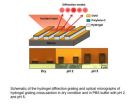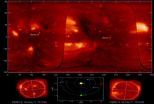(Press-News.org) WEST LAFAYETTE, Ind. - Researchers are developing a new type of biological and chemical sensor that has few moving parts, is low-cost and yet highly sensitive, sturdy and long-lasting.
The "diffraction-based" sensors are made of thin stripes of a gelatinous material called a hydrogel, which expands and contracts depending on the acidity of its environment.
Recent research findings have demonstrated that the sensor can be used to precisely determine pH - a measure of how acidic or basic a liquid is - revealing information about substances in liquid environments, said Cagri Savran (pronounced Chary Savran), an associate professor of mechanical engineering at Purdue University.
The sensor's simple design could make it more practical than other sensors in development, he said.
"Many sensors being developed today are brilliantly designed but are too expensive to produce, require highly skilled operators and are not robust enough to be practical," said Savran, whose work is based at Purdue's Birck Nanotechnology Center in the university's Discovery Park.
New findings show the technology is highly sensitive and might be used in chemical and biological applications including environmental monitoring in waterways and glucose monitoring in blood.
"As with any novel platform, more development is needed, but the detection principle behind this technology is so simple that it wouldn't be difficult to commercialize," said Savran, who is collaborating with another team of researchers led by Babak Ziaie, a Purdue professor of electrical and computer engineering and biomedical engineering.
Findings are detailed in a paper presented during the IEEE Sensors 2010 Conference in November and also published in the conference proceedings. The paper was written by postdoctoral researcher Chun-Li Chang, doctoral student Zhenwen Ding, Ziaie and Savran.
The flexible, water-insoluble hydrogel is formed into a series of raised stripes called a "diffraction grating," which is coated with gold on both the stripe surfaces and the spaces in between. The stripes expand and contract depending on the pH level of the environment.
Researchers in Ziaie's lab fabricated the hydrogel, while Savran's group led work in the design, development and testing of the diffraction-based sensor.
The sensors work by analyzing laser light reflecting off the gold coatings. Reflections from the stripes and spaces in between interfere with each other, creating a "diffraction pattern" that differs depending on the height of the stripes.
These diffraction patterns indicate minute changes in the movement of the hydrogel stripes in response to the environment, in effect measuring changes in pH.
"By precise measurement of pH, the diffraction patterns can reveal a lot of information about the sample environment," said Savran, who by courtesy is an associate professor of biomedical engineering and electrical and computer engineering. "This technology detects very small changes in the swelling of the diffraction grating, which makes them very sensitive."
The pH of a liquid is recorded on a scale from 0 to 14, with 0 being the most acidic and 14 the most basic. Findings showed the device's high sensitivity enables it to resolve changes smaller than one-1,000th on the pH scale, measuring swelling of only a few nanometers. A nanometer is about 50,000 times smaller than the finest sand grain.
"We know we can make them even more sensitive," Savran said. "By using different hydrogels, gratings responsive to stimuli other than pH can also be fabricated."
The work is ongoing.
"It's a good example of collaborations that can blossom when labs focusing on different research are located next to each other," Savran said. "Professor Ziaie's lab was already working with hydrogels, and my group was working on diffraction-based sensors. Hearing about the hydrogels work next door, one of my postdoctoral researchers, Chun-Li Chang thought of making a reflective diffraction grating out of hydrogels."
INFORMATION:
The Office of Technology Commercialization of the Purdue Research Foundation has filed for U.S. patent protection on the concept.
Related website:
Cagri A. Savran:
https://engineering.purdue.edu/ME/People/ptProfile?id=2871
IMAGE CAPTION:
This diagram depicts a new type of "diffraction-based" sensor made of thin stripes of a gelatinous material called a hydrogel, which expands and contracts depending on the acidity of its environment. The new type of biological and chemical sensor has few moving parts and works by precisely determining pH, revealing the identity of substances in liquid environments such as water or blood. The microscopic images at bottom show how the hydrogel stripes expand with decreasing acidity. (Birck Nanotechnology Center, Purdue University)
A publication-quality photo is available at http://www.purdue.edu/uns/images/2011/savran-sensors.jpg
Abstract on the research in this release is available at:
Hydrogels used to make precise new sensor
2011-02-09
ELSE PRESS RELEASES FROM THIS DATE:
Detecting pathogens in waterways: An improved approach
2011-02-09
This press release is available in Spanish.
U.S. Department of Agriculture (USDA) scientists have come up with a way to detect pathogenic Escherichia coli and Salmonella bacteria in waterways at lower levels than any previous method. Similar methods have been developed to detect pathogenic E. coli in meat products, but the approach by the scientists with USDA's Agricultural Research Service (ARS) represents a first for waterways.
ARS is USDA's principal intramural scientific research agency, and this research supports the USDA priority of ensuring food safety.
When ...
UT Study: Charismatic leadership can be measured, learned
2011-02-09
KNOXVILLE -- How do you measure charisma? That's the question UT professor Kenneth Levine seeks to answer.
Much has been written in business management textbooks and self-help guides about the role that personal charisma plays in leadership. But according to a newly published study co-authored by Levine, a University of Tennessee, Knoxville, communications studies professor, until recently no one was able to describe and measure charisma in a systematic way.
Levine said the large amount of academic literature on charismatic leadership never defined what it means to ...
The hitch in the drug? The itch in the drug
2011-02-09
Scratching deep beneath the surface, a team of researchers from the University of California, San Diego School of Medicine and three South Korean institutions have identified two distinct neuronal signaling pathways activated by a topical cream used to treat a variety of skin diseases. One pathway produces the therapeutic benefit; the other induces severe itching as a side effect.
The findings, published in this week's early online edition of the Proceedings of the National Academy of Sciences, point to the possibility of designing future drugs that effectively treat ...
Dramatic improvement in Parkinson disease symptoms
2011-02-09
New Rochelle, NY, February 8, 2011—Successful intranasal delivery of stem cells to the brains of rats with Parkinson disease yielded significant improvement in motor function and reversed the dopamine deficiency characteristic of the disease. These highly promising findings, reported in Rejuvenation Research, a peer-reviewed journal published by Mary Ann Liebert, Inc. highlight the potential for a noninvasive approach to cell therapy delivery in Parkinson disease–a safer and effective alternative to surgical transplantation of stem cells. The article is available free online. ...
NRL researchers view the sun in 3-D
2011-02-09
Beginning on February 6, 2011, the two STEREO spacecraft are 180 degrees apart providing Naval Research Laboratory (NRL) scientists with a 360-degree view of the Sun. NASA's STEREO (Solar Terrestrial Relations Observatory) spacecraft were launched on October 25, 2006, and have been gathering spectacular images of solar activity, especially solar storms, since the mission began.
A key component of the STEREO mission is NRL's Sun Earth Connection Coronal and Heliospheric Investigation (SECCHI), a suite of five scientific telescopes that observe the solar corona and inner ...
Scientists develop method to identify fleetingly ordered protein structures
2011-02-09
LA JOLLA, CA – February 8, 2011 - A team of scientists from The Scripps Research Institute and the University of California, San Diego (UCSD) have developed a novel technique to observe previously unknown details of how folded structures are formed from an intrinsically disordered protein. The insights could help scientists to better understand the mechanism of plaque formation in neurodegenerative disorders such as Parkinson's and Alzheimer's diseases.
The results of the study, which has broad implications for the field, were recently published in an advanced, online ...
New techniques for stapling peptides could spur development of drugs for cancer
2011-02-09
BUFFALO, N.Y. -- Researchers at the University at Buffalo have devised two new ways of "stapling" peptide helices to prevent these medically important molecules from losing their shape and degrading in the presence of enzymes.
The discovery could help speed the development of peptide-based drugs against diseases including cancer. UB scientists say the methods they pioneered are simpler than existing techniques, one of which employs an expensive ruthenium catalyst to connect chemical side chains that protrude from the main body of helical peptides.
"There's a lot of potential ...
Gene protects lung from damage due to pneumonia, sepsis, trauma, transplants
2011-02-09
Lung injury is a common cause of death among patients with pneumonia, sepsis or trauma and in those who have had lung transplants. The damage often occurs suddenly and can cause life-threatening breathing problems and rapid lung failure.
There are no effective treatments. Patients usually are put on ventilators to give their lungs a chance to heal, but there is little else doctors can do but wait and hope for the best.
Now, researchers at Washington University School of Medicine in St. Louis report they have identified a gene that limits damage to the lung during acute ...
Electronic cigarettes hold promise as aid to quitting
2011-02-09
A study led by Boston University School of Public Health (BUSPH) researchers reports that electronic cigarettes are a promising tool to help smokers quit, producing six-month abstinence rates nearly double those for traditional nicotine replacement products.
In a study published online ahead of print in the American Journal of Preventive Medicine, researchers found that 31 percent of respondents reported having quit smoking six months after first purchasing an electronic cigarette, a battery-powered device providing tobacco-less doses of nicotine in a vaporized solution. ...
Not just for raincoats
2011-02-09
Researchers from Northwestern University and the Massachusetts Institute of Technology (MIT) have studied individual water droplets and discovered a miniature version of the "water hammer," an effect that produces the familiar radiator pipe clanging in older buildings.
In piping systems, the water hammer occurs when fluid is forced to stop abruptly, causing huge pressure spikes that can rupture pipe walls. Now, for the first time, the researchers have observed this force on the scale of microns: such pressure spikes can move through a water droplet, causing it to be impaled ...


